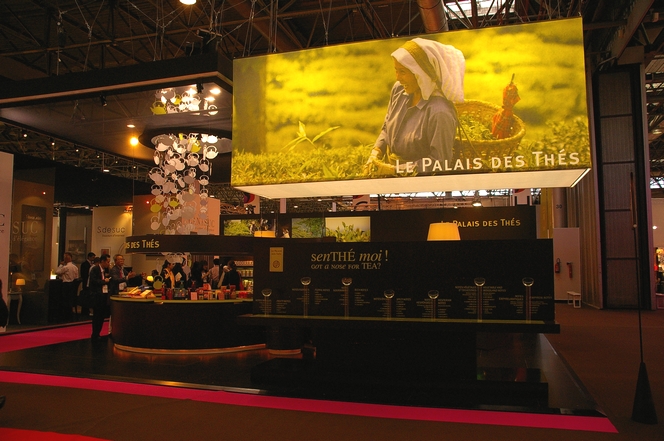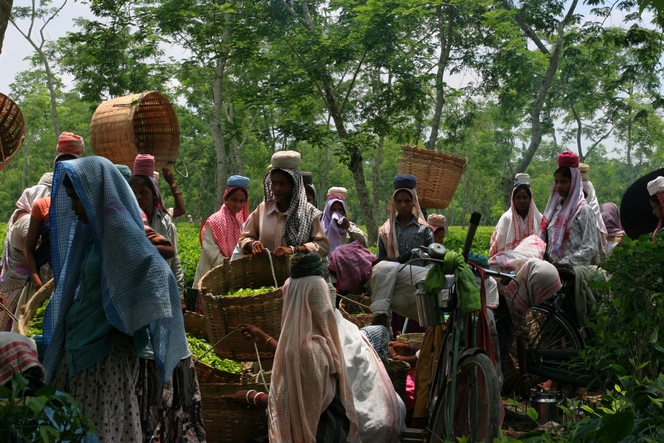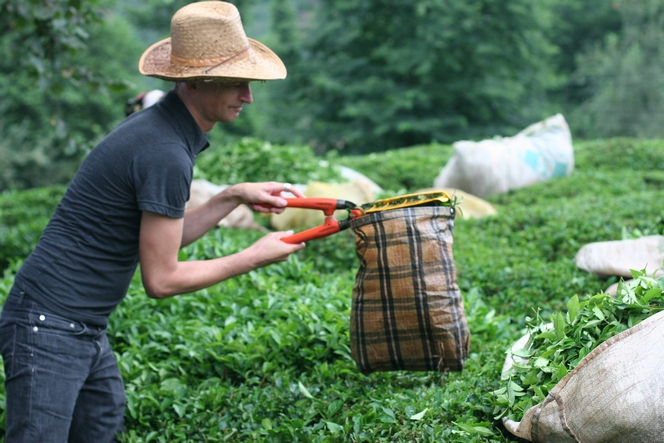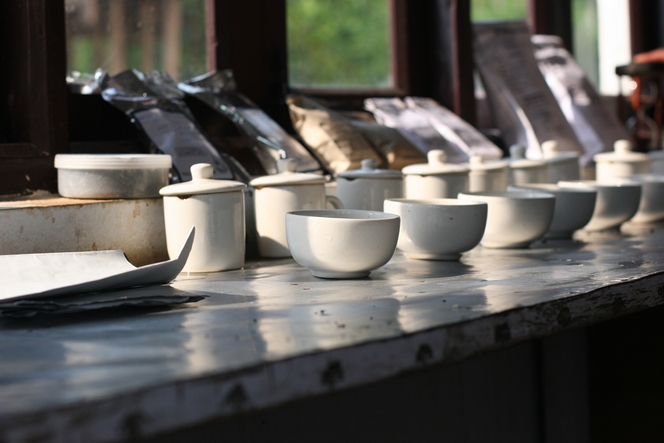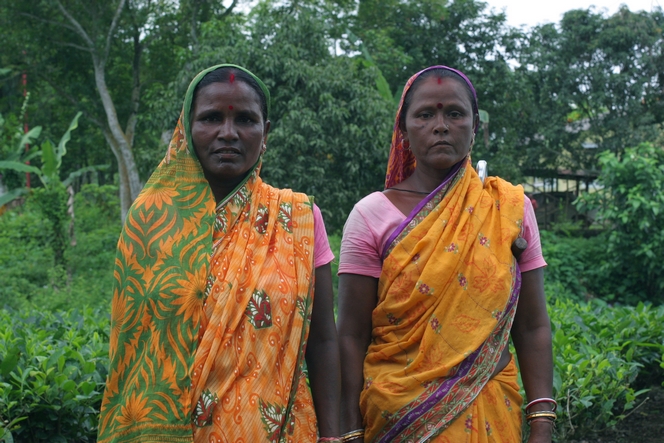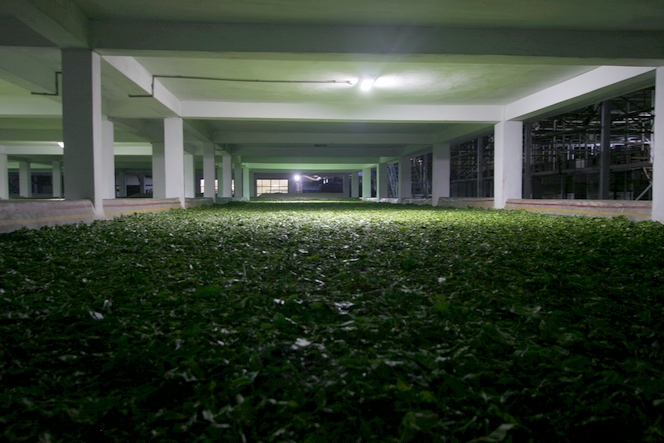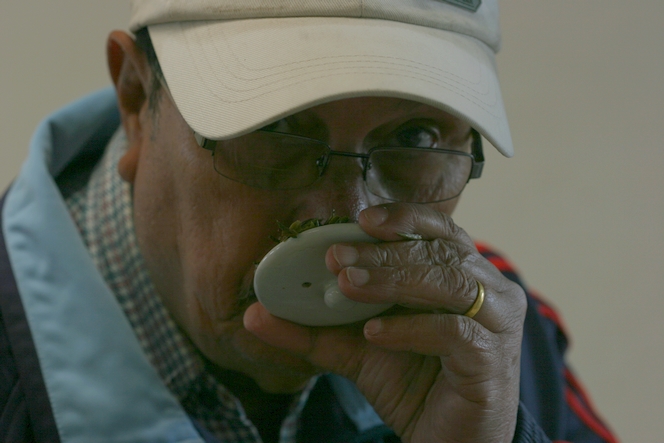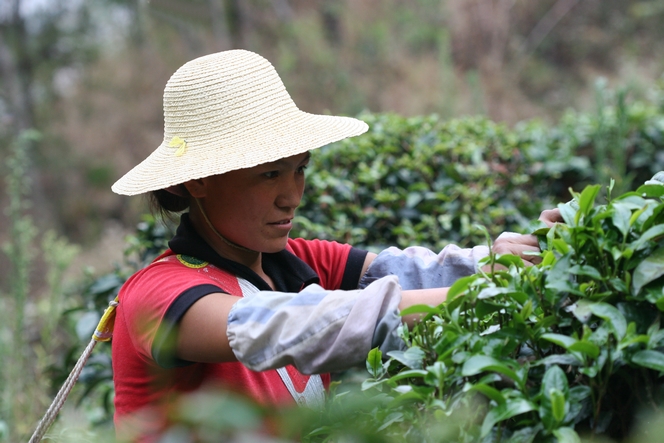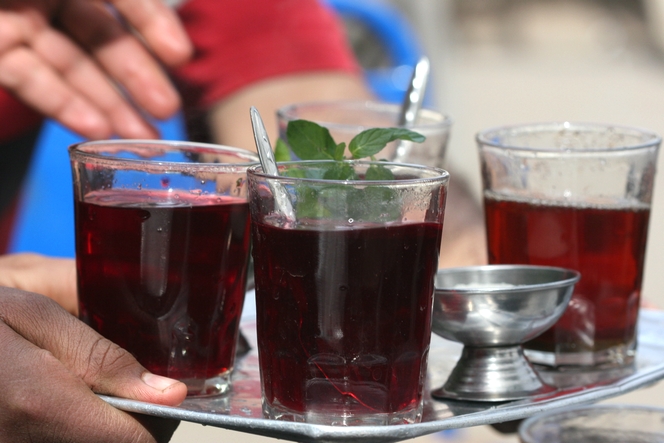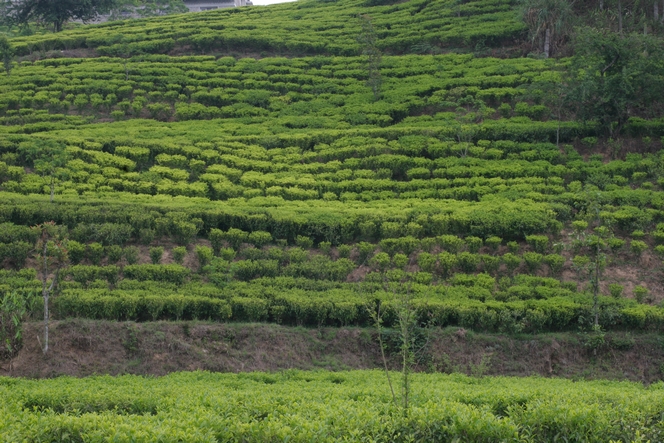The Maison & Objet fair in Paris has just ended. Twice a year, trade visitors from all over the world come to this great event which, as its name indicates, focuses on homeware and objects. The tableware sector is an important element of this fair, which is why Palais des Thés was there with a stand, to present its latest collections. An illuminated river of teapots descending from the ceiling appears to amuse this laughing tea picker, projected and lit up on the outskirts of Paris.
ARCHIVE FOR 2011
Tea pluckers looking like queens
In Assam, as soon as harvesting is finished, the pluckers assemble, men on one side, women on the other, and they set off with their precious baskets to the place where they will be weighed. Some women hold their baskets under their arms, but most rest them on their heads. A rolled-up piece of cloth placed precisely on the crown of the head serves to support the basket. These splendidly colourful fabrics look like crowns, making their wearers look like queens, I think.
In Turkey, one uses clippers to pluck tea
In general, good tea should be plucked by hand. The leaf bud and the first two leaves on each stem are plucked between the thumb and index finger, with a precise, rapid movement.
It is best to avoid the use of clippers, although they are commonly used in some regions of the world where tea is produced with less emphasis on quality. Although the farmers in the Rize region of Turkey are very friendly, hospitable people, it has to be said that their harvesting methods massacre the tea.
Here, I have dared to give them a helping hand and I’m a little ashamed, I must admit, to be caught red-handed using their tool.
Tasting rooms have windows to let in the sunlight
When tasting tea, it is good to have a source of natural light in which to judge the leaves and the infusion, as well as the liquor. It means you can assess the tea not just on its taste and aroma, but also on its appearance.
This is why, on most plantations, the tasting room has windows right down one side, to let in the sunlight. The cups of tea are placed along the windows, and while the tea is infusing, I can spread the dry leaves on a card in order to get a good look at them and judge the quality of the plucking. Or, while waiting for the timer to tell me when the infusion is ready, I can take my camera, as I did here in Darjeeling, and find the best angle to immortalise this beautiful morning light.
In Assam, there is a hierarchy in tea harvesting
There is quite a hierarchy among the people in charge of harvesting tea in Assam. This is true on the large plantations, anyway; there are also independent plots owned by small producers.
On the large plantations, the manager supervises the assistant managers, who organise the babus, whose role is to oversee the work of the sardars, who themselves are responsible for supervising the team of workers.
In this photo taken on the Dufflating plantation you can admire two sardars, who don’t look particularly approachable on first glance. But perhaps they are just reflecting, in their serious expressions, the position of authority they hold.
Tea leaves spread out as far as the eye can see
In Assam, anything related to tea processing takes place on a massive scale, because of the incredible yield they get here: four times higher than in Darjeeling. The plantations themselves cover a much larger area than elsewhere in the country.
Take the withering, for example. Instead of troughs 10 to 15 metres wide, which I am used to seeing in other parts of India, here the leaves are spread out as far as the eye can see. I took this photo at night, and the dim light adds to the mystery of this essential stage in tea processing. During the withering, the leaf will lose much of its water content (up to 40% for Assams; up to 70% for Darjeelings).
Smelling the wet tea leaves : an essential step
When you taste tea, the first thing you do is look at the dry tea leaf, of course. Then you bring the liquor to your lips and analyse the flavours, aromas and texture. But assessing the qualities of a tea includes another important step: smelling the wet leaves that have just been infused. For this, we can follow the example of Peter Orchard, manager of Kuwapani Tea Estate, who you see here, plunging his nose into the leaves while they’re still warm. Peter is looking at me but he is elsewhere, concentrating intently on the smell of the infusion, a smell which says a great deal about the quality of the lot he has just tasted.
Camellia : a shrub with a tough foliage
In many countries, the men and women who pluck tea leaves wear a type of sleeve made from a light canvas, which covers part of the arm.
Camellia is quite a tough shrub, and at the end of the day, without this protection, which can be worn directly on bare skin or over the top of a garment, the pluckers’ arms would be covered in scratches.
I expect this young woman from Yunnan, who looks rather stylish beneath her straw hat, would agree.
Hot tea is more refreshing than cold tea
The summer is upon us in France, and with it comes the heat. Many people like iced tea at this time of year, simply because they want a refreshing drink. But it’s funny that in regions where it is very hot – like the Sahara, but there are many other examples – people tend to drink their tea hot. In fact, hot tea is considered more refreshing than cold tea. This is because the closer the liquid’s temperature is to body temperature, the less it will provoke a temperature change. And this temperature change is one of the reasons we sweat.
Our love of iced drinks comes from the other side of the Atlantic, and when a food-related fashion arrives from that region, we are not necessary wrong to question it. My suggestion for fans of iced tea is to shun the overly sweetened – in my opinion – commercial varieties and instead to make your own delicious teas using water at room temperature, and to drink them chilled.
Or, as I am here to tell you about the different customs relating to tea, you can also celebrate the arrival of the warm season by drinking a hot tea with mint leaves, like this one, served on the banks of the river Nile.
Tea trees growing quite freely in Kuwapani
I am very aware of how lucky I am to be able to spend several months a year walking through tea fields. I never tire of it. Each tea plantation looks different. Some slope, others are flat, some are densely planted, others sparsely. Some are wooded, but the trees vary from one region to another.
What I like about this photo taken on Kuwapani Tea Estate (Nepal) is the contrast in these tea trees planted in rows that are quite orderly, yet which leave room for some interesting effects. The wavy lines follow the irregularities of the terrain, with a certain sense of freedom. They have adapted to their environment. We can see how the hand of man has marked out a neat line, and nature, rebellious, has ignored it.

